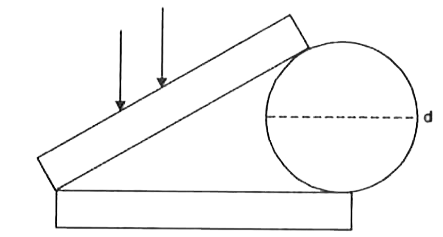A broad source of light λ=6800Å illumintates normally two glass plates 12 cm long. They touch at one end and are separated by a wire 0.048 mm. In diameter at the other end.How many bright fringes appear over the 12 cm. Distance.
141
120
101
151
The correct Answer is:A

For bright fringes formed by a gap of wedge due to light incident normally
2d=(n+12)λ
Here d = 0.0048 cms
diameter of wire (an gap) at the point where nth fringe is formed.
∴n=2dλ−12
=2×0.00486800×10−8−12
= 141
Topper's Solved these Questions
- WAVE OPTICS BOOK - MODERN PUBLICATIONCHAPTER - WAVE OPTICS EXERCISE - MCQ LEVEL- II (ASSERTIONS)
2 Videos
- WAVE OPTICS BOOK - MODERN PUBLICATIONCHAPTER - WAVE OPTICS EXERCISE - MCQ LEVEL- II (PARAGRAPH QUESTIONS)
28 Videos
- WAVE OPTICS BOOK - MODERN PUBLICATIONCHAPTER - WAVE OPTICS EXERCISE - MCQ LEVEL -1 (PARAGRAPH QUESTIONS )
34 Videos
- WAVE MOTIONBOOK - MODERN PUBLICATIONCHAPTER - WAVE MOTIONEXERCISE - RECENT COMPETITIVE QUESTIONS
18 Videos
- WORK , POWER , ENERGY AND COLLISIONSBOOK - MODERN PUBLICATIONCHAPTER - WORK , POWER , ENERGY AND COLLISIONSEXERCISE - Revision Test
40 Videos
Similar Questions
A broad sources of light of wavelength 680nmilluminated normally two glass plates.120nmlong that meet at one end and are separated by a wire0.048mmin diameter at the other end,Find the number of bright fringes formed over the 120nmdistance.

View Solution_E01_041_Q01.png)
Light wavelength 650 nm is incident normally upon a glass plate the glass plate rests on top of second plate so that hey touch at one end and are separated by 0.0325 mm at the other end as shown in the figure. Which range of values contains the horizontal separation between adjacent bright fringes?
View Solution
Knowledge Check
_E01_041_Q01.png)
Light wavelength 650 nm is incident normally upon a glass plate the glass plate rests on top of second plate so that hey touch at one end and are separated by 0.0325 mm at the other end as shown in the figure. Which range of values contains the horizontal separation between adjacent bright fringes?A1.1 mm to 1.4 mmB1.4 mm to 2.8 mmC2.8 mm to 4.2 mmD4.2 mm to 5.6 mmIn Yonung's double-slit experiment, two slits which are separated by 1.2 mm are illuminated with a monochromatic light of wavelength 6000Å The interference pattern is observed on a screen placed at a distance of 1 m from the slits. Find the number of bright fringes formed over 1 cm width on the screen.
A25B12C15D20A plane monochromatic light falls normally on a diaphragm with two narrow slits separated by a distance d = 2.5 mm. A fringe pattern is formed on the screen placed at D = 100 cm behind the diaphragm. If one of the slits is covered by a glass plate of thickness 10μm, then distance by which these fringes will be shifted will be :
A2 mmB3 mmC4 mmD5 mm
In Yonung's double-slit experiment, two slits which are separated by 1.2 mm are illuminated with a monochromatic light of wavelength 6000Å The interference pattern is observed on a screen placed at a distance of 1 m from the slits. Find the number of bright fringes formed over 1 cm width on the screen.
View SolutionLight with wavelength λ=0.55μm from a distant point source falls normally on the surface of a glass wedge. A fringe pattern whose neighbouring maxima on the surface of the wedge are separated by a distance Δx=0.21mm is observed in reflected light. Find:
(a) the angle between the wedge faces,
(b) the degree of light monochromatism (Δλ/λ) if the fringes disappear at a distance l≈1.5cm from the wedge's edge.
View SolutionThe circumferences of two circles are touching externally. The distance between their centres is 12 cm. The radius of one circle is 7 cm. Find the diameter (in cm.) of the other circle.
View SolutionThe circumferences of two circles are touching externally. The distance between their centres is 12 cm. The radius of one circle is 7 cm. Find the diameter (in cm.) of the other circle.
View SolutionTwo slits separated by a distance of 0.5 mm are illuminated by light of wavelength 5000 Å. The interference fringes are obtained on a screen at a distance of 1.2 m. what is the phase difference between two interfering waves at a point 3 mm from the central bright fringe?
View Solution
